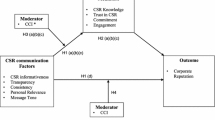Abstract
Much emphasis is placed upon the benefits to both parties of a ‘good’ relationship between banks and their small business customers. Having explained the significance of SMEs in the U.K. Economy, the papers goes on to consider, briefly, some of the arguments which underpin the rationale for these relationships. The roles of information and communication are discussed and the poor co-ordination between banks, SMEs and their accountants is highlighted. Evidence from over 6,000 small businesses in response to the Forum of Private Business survey in 1994 is then presented. This demonstrates the strong positive association between more participative relationships and more positive perceptions of their banks by firms. Finally it is suggested that a virtuous circle of information and communication could be established if the parties cooperate in a systematic process of risk assessment.
Similar content being viewed by others
References
Berger, A. N. and G. F. Udell, 1989, ‘Some Evidence on the Empirical Significance of Credit Rationing’, Working Paper, Salomon Brothers Center for the Study of Financial institutions, New York University.
Berger, A. N. and G. F. Udell, 1993, ‘Lines of Credit, Collateral and Relationship Lending in Small Firm Finance’, Working Paper (S-93/17), Salomon Brothers Center for the Study of Financial institutions, New York University.
Bester, H., 1987, ‘The Role of Collateral in Credit Markets with Imperfect Information’, European Economic Review 31, 887–899.
Bester, H. and M. Hellwig, 1989, ‘Moral Hazard and Equilibrium Credit Rationing: An Overview of the Issues’, in G. Bamber and K. Spremann (eds.), Agency Theory, Information and Incentives, Berlin: Springer-Verlag.
Binks, M. R., C. T. Ennew and G. V. Reed, 1988, The Survey of Private Businesses on Banks and Small Firms, London: Forum of Private Business.
Binks, M. R., C. T. Ennew and G. V. Reed, 1990, Small Businesses and their Banks, London: Forum of Private Business.
Binks, M. R., C. T. Ennew and G. V. Reed, 1992, Small Businesses and Their Banks: 1992, Knutsford, Cheshire: Forum of Private Businesses.
Binks, M. R. and C. T. Ennew, 1994, Small Businesses and Their Banks: (Reports 1 and 2), Knutsford, Cheshire: The Forum of Private Business.
Chan, Yuk-shee, and Anjan V. Thakor, 1987, ‘Collateral and Competitive Equilibria with Moral Hazard and Private Information’, Journal of Finance XLII(2), June.
Constand, R. L., J. S. Osteryoung and D. A. Nast, 1991, ‘Revolving Asset Backed Lending Contracts and the Resolution of Debt-Related Agency Problems’, Journal of Small Business Finance 1(1), 15–28.
Cressy, Robert C., 1996a, ‘Are Startups Debt-rationed?’, The Economic Journal 106 (September), 1253–1270.
Cressy, Robert C., 1996b, ‘Commitment Lending under Asymmetric Information: Theory and Tests on U.K. Startup Data’, Small Business Economics (forthcoming).
Edwards, P. and P. W. Turnbull, 1994, ‘Finance for Small and Medium Sized Enterprises: Information and the Income Gearing Challenge’, International Journal of Bank Marketing 12(6), 3–9.
Hakim, C., 1989, Identifying Fast Growth in Small Firms' Employment Gazette 97(1).
Himmelberg, Charles P. and Bruce C. Peterson, 1994, ‘R&D and Internal Finance: A Panel Study of Small Firms in High-tech Industries’, Review of Economics and Statistics, 38–51.
HMSO, 1993, Size Analysis of United Kingdom Businesses 1993.
ICAEW, 1996, Barriers to Growth: A Report by the Enterprise Group of the ICAEW, Milton Keynes.
Jovanovic, Boyan, 1982, ‘Selection and the Evolution of Industry’, Econometrica 50(3), May, 649–670.
Keasey, K. and R. Watson, 1993, Small Firm Management, Basil Blackwell, Oxford.
Leeth, John D. and Jonathan A. Scott, 1989, ‘The Incidence of Secured Debt: Evidence from the Small Business Community’, Journal of Financial and Quantitative Analysis 24 (September), 379–393.
Mason C. and R. Harrison, 1994, ‘Informal Venture Capital in the U.K.’, in A. Hughes and D. J. Storey (eds.), Finance and the Small Firm, Routledge.
Moore, Barry, 1993, ‘Financial Constraints to the Growth and Development of Small Hi-Technology Firms’, Working Paper No. 31, Small Business Research Centre, University of Cambridge, July.
Peterson, Mitchell A. and Raghuram G. Rajan, 1994, ‘The Benefits of Lending Relationships: Evidence from Small Business Data’, Journal of Finance XLIX(1), March, 3–37.
Stiglitz Joseph E. and Andrew Weiss, 1981, ‘Credit Rationing in Markets with Imperfect Information’, American Economic Review 71(3), 393–410.
Author information
Authors and Affiliations
Rights and permissions
About this article
Cite this article
Binks, M.R., Ennew, C.T. The Relationship Between U.K. Banks and Their Small Business Customers. Small Business Economics 9, 167–178 (1997). https://doi.org/10.1023/A:1007923907325
Issue Date:
DOI: https://doi.org/10.1023/A:1007923907325




